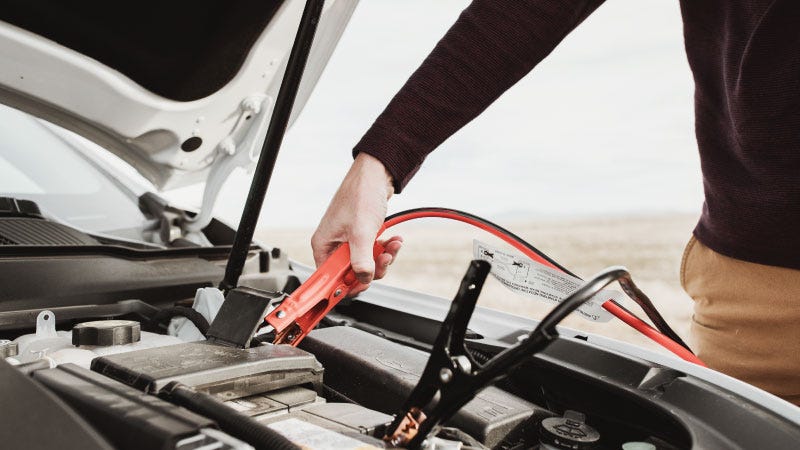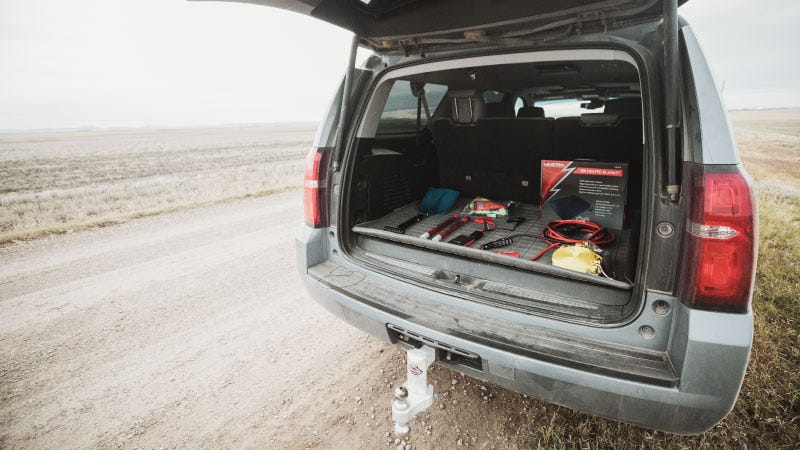What Should you Have in a Vehicle Winter Emergency Kit?

Going anywhere for the holidays this year? Traveling during the winter months in the Northwest can sometimes be treacherous. One moment everything is fine and then in the next moment, it’s not. Especially with our unpredictable winters, you should always be prepared and keep a well-stocked winter emergency kit in your car or truck.
Keeping a winter emergency kit in your vehicle means you’ll have the right tools to handle difficult situations should they arise. It also means that you’ll be prepared to tackle those moments much better than you would if you were not so prepared.
But, what should you have in a vehicle winter emergency kit? What items are really necessary? From flares to flashlights, we’ve compiled a helpful list of 22 must-have items, we think, you’ll want to be sure to include in your kit before you hit the road this winter season.
So, take a look, and be safe out there!
22 Must Have Items to Include in a Vehicle Winter Emergency Kit
1. Road Emergency Flares
In most states, if a vehicle is stopped in a traffic lane then they are supposed to put out some form of warning signals. Flares are good for indicating a hazardous situation and advising other vehicles to pass with caution and work in any weather and lighting situation. They can also double as emergency firestarters or signals in distress.
2. Instant Tire Repair
While having a spare tire and tools is always the best option for a flat tire, this simply isn't always possible. Some vehicles can't carry a spare and some situations could mean that you can't get a jack under the vehicle safely. That's where instant tire repair products come in! Fix-a-Flat is a quick way to repair small tire punctures in an emergency. This can also provide enough inflation to lift a tire rim off of the ground.


3. Booster Cables
Cold weather makes batteries die even faster than normal. If you get stuck out on the highway, or even just in a parking lot then you want to have a way to get your car going again until you can get a new battery installed. Luckily, booster cables when connected to another vehicle, can help start a dead battery and get you back on the road!
4. Tow Straps
We've all been there. The slippery icy roads get a little too much for the rubber on your tires and you drive right into a ditch or snow berm. Hopefully you can get out, but if not then a tow strap is helpful for getting pulled back onto the road or even pulling out a stuck vehicle.
5. Windshield Ice Scraper
This should be standard issue for every vehicle sold in the cold Northern areas, but sadly it isn't. It's easy to get caught off guard in the morning when the frost or snow freezes to your windshield, but that's not the dangerous part. If you have ever driven in freezing rain then you know that even the hottest defroster isn't going to stop a thick translucent layer of messy ice from blocking your eye sight. A vehicle snow brush and ice scraper will help keep your visibility clear.
6. Waterproof Matches
Waterproof matches are ideal for use in damp conditions. They are more expensive than the cheap matches that you might get at your local gas station, but a whole lot cheaper than a funeral. And that's exactly what could happen if you end up stranded in the winter in Montana and can't make a fire. The matches last a LONG time in their container so you can just set it and forget it with this essential survival item.
7. First Aid Kit
Available in a variety of styles, these kits include a variety of aids, plus instructions for what to do in an emergency situation. Small kits are good for boo-boos with kids or busted knuckles from changing that tire earlier. More serious and complete kits have basic medicines in them as well as ways to stop larger bleeding and instructions for serious interventions. It's a good idea to keep the numbers for local emergency services in your kit as well.
8. Survival Candle
These are pretty neat. A survival candle offers both heat and light, and some can burn up to 36 hours. This means that you can survive more easily over night in an emergency and have more comfort while you do it. A candle lit at night can also make it more easy for emergency services to find you if you end up off of the road.
9. Lighter
While matches are a great option, some people prefer lighters. A pocket lighter can be lightweight, windproof, waterproof and offers immediate heat. You can also get larger more powerful lighters that are closer to torches and can help to light even damp wood more easily allowing you to get critical heat in the winter time.
10. Knife
From folding to fixed, knives are always useful tools to have during an emergency. Knife and cutlery options vary wildly with application and budget so think through how much space you have and what you really need here. A half serrated half straight-edge knife that's around 3-4" in blade length will usually be more than enough to cut wood into kindling, cut food, supplement your tool bag, and even use as protection in extreme situations.
11. Multi-Tool
Multi tools has features that get the toughest jobs done. Like... all of them. While they don't do any one job great, they can do many things if you need them to. This means that you can save weight and space while not sacrificing your abilities in an emergency situation. You should look for a multi tool that will augment the rest of what you have with you. Things like scisorrs, a saw, pliers, and some screwdriver options make for a handy tool that will more than pull its own weight.
12. Hatchet
Good for splitting wood and clearing debris, hatchets, axes, and saws will help you cut through things that are too much for your knife or multitool. Unfortunately, these tools tend to be much larger so depending on how much space you have you may need to sacrifice utility and either get a smaller version or not carry one at all. Small simple hatchets provide the best compromise between size and utility and can easily be used to chop at large chunks of ice, fell small trees, or break windows to rescue others from roll overs.
13. Flashlight
Not all emergencies occur in the daylight. A good flashlight can be used both as a signal and as a light in dark situations. Headlamps and handheld flashlights each have their benefits and draw backs, but headlamps are generally a better emergency option due to their size and ability to use hands free. Lumens (the measurement of brightness that the lamp makes) should be at least 300, but bigger is better when it comes to heaplamps. Many also offer different settings that will send out distress flashes or provide red light to not destroy your night vision. Make sure that your batteries are charged or you have extras so you aren't caught in the dark.
14. Emergency Blanket
Emergency blankets keep you warm until help arrives. While you could just keep a big wool blanket in your trunk, the more space and money efficient approach is to get a thermal emergency blanket. They fold up to a pocket sized pouch and reflect your heat back at you. On top of that they are shiny so emergency responders looking for you and more likely to see the relection from the blanket if you are sleeping or unconsious.
15. Warning Reflective Triangle
Like flares, these are good for indicating a hazardous situation and advising other vehicles to pass with caution. It's best to have at least three of them so that you can merge traffic over and around your vehicle.
16. Lightstick
Lightsticks can be used as warning lights, marker lights, signal lights, dive lights or safety lights. Also known as Chem-lights, these plastic bars are easy to use since you just need to crack the casing by bending them. They are non-toxic and do not create and heat or fumes so they are safe to use in enclosed areas or by children as well. They last between 4 to 2 hours depending on size so you can rest assured that you will be easy to spot. As a bonus, tie one to the end of a rope or paracord and swing it quickly over your head to create an easy to see circular signal that is visible sometimes miles away.


17. Collapsible Shovel
Digging yourself out can be the difference between a short stay in the snow and freezing to death on a remote road overnight. Collapsible shovels are nice since they can become much more compact than their traditional counterparts. Shovels can help you dig out tires, or even create snow shelters.
18. Extra AA Batteries
Batteries are a must-have for any electronic device you keep in your vehicle. AA batteries tend to be the most common, but make sure to check what your equipment needs to work and keep those on hand.
19. Granola Bars
Keeping warm burns a lot of calories. For short times stuck in the snow you can renew your energy and help you keep your strength up with energy dense foods like energy bars. These are also great if you have kids who will need a snack sooner than most adults. Having some small games for kids is a great addition for a family's emergency bag as well. Make sure that the shelf life is long enough to keep in your vehicle for a while for whatever snack you choose.
20. Camp Stove with Fuel Canister
Hopefully you get yourself out or get saved quickly, but what if that doesn't happen? Camp stoves and fuel are ideal for boiling water, heating food, and keeping you warm. They can help you make warm drinks, heat up water to unfreeze stuck parts, or make food if you're stuck longer than expected.
21. Emergency Dried Food Meals
To go along with camp stoves, camping and hiking meals are crucial for longer times out in the cold without support. You need to keep up your energy levels so that your body stays healthy and strong until you're rescued. Shelf stable dried camp food are fantastic for this since they are simple to use, energy dense, and some can even last for several years.
Which dried food meals taste the best? Watch our Omeals vs. Mountain House challenge here.
22. Paracord/ Rope
Paracord was (and still is) used for rigging parachutes so you know that it is incredibly strong and lightweight. It is good for helping to create shelter, repairing clothing or tents, making ladders, and more. Different lengths are available starting around 100' and going up.


Staying safe on the road means being prepared. Every responsible driver should have a comprehensive emergency and tool kit for their vehicle. Make sure to keep yourself and your family safe on your winter trips this year by using the North 40 Vehicle Winter Emergency Kit suggestions above.
Safe travels from North 40 Outfitters!










